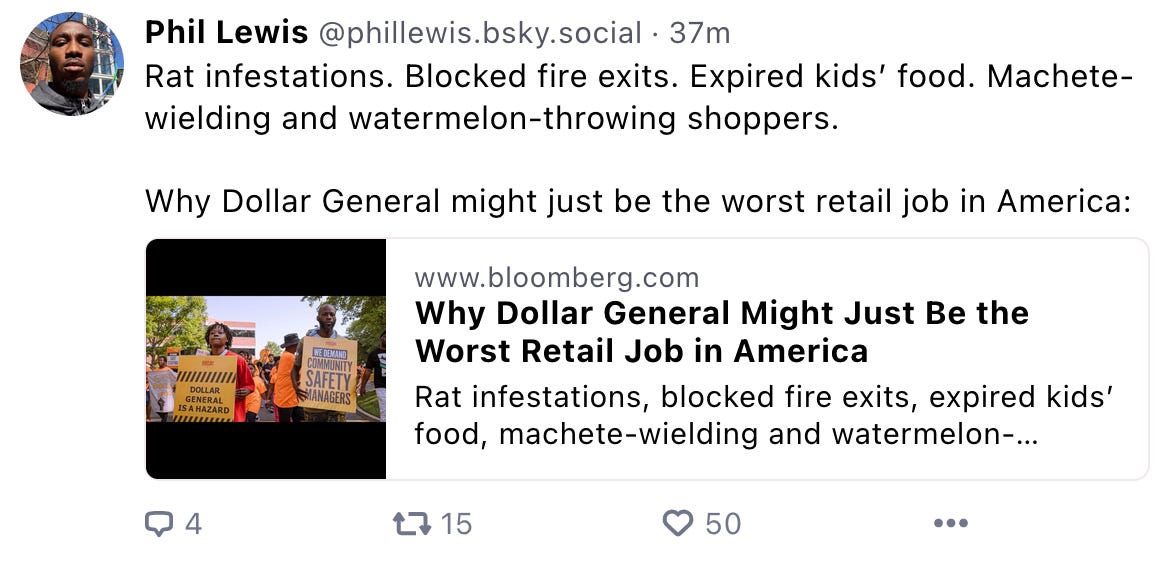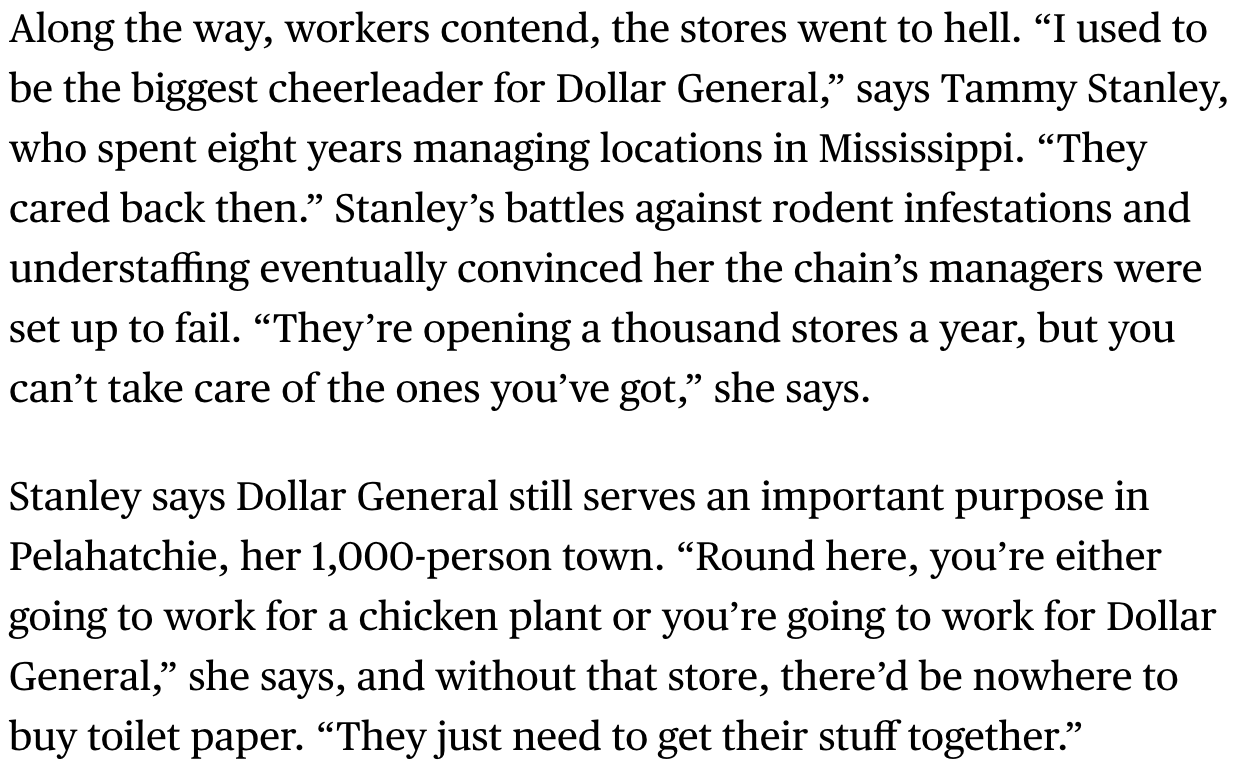Sorry, but you lost me at "rat infestations"
Dollar General sounds like what Neiman-Marcus might become in a "Mad Max" sequel
David Williams was in his first months working at a Dollar General in New Orleans when a manager ordered him to block the fire exits. While he was unloading sausages and soup cans, the manager called him over to a fire door and showed him how to build a pyramid of water cases that would obstruct it. The idea was to deter shoplifting. Williams, who was a Hurricane Katrina refugee in his teens, says he knew this was dangerous, and he felt guilty—especially when customers asked about it. But it seemed clear that, if he wanted to keep his job, he had to do it, so he did. A couple of years later, a week before Christmas 2021, the store caught fire.
Fortunately the fire happened before dawn, and no one was inside. Williams walked over on his day off to watch the store burn. From 20 feet away, all he could see was smoke. Since the place reopened in summer 2022, his bosses haven’t asked him to block the fire exits, but they still have other people doing it, he says. “I’m just thinking to myself, ‘You really haven’t learned nothing.’ ”
I’ve been inside a Dollar General store perhaps four or five times, and each time has been by accident or happenstance. It wasn’t that I was looking for anything, more that it was an exercise in cultural anthropology. What sorts of things could one find for a buck, I wondered?
Of course, no matter where you are, you probably don’t have to go far to find a Dollar General store. The chain has over 19,000 locations, meaning Dollar General stores are everywhere.
Its main competitor, Dollar Tree Inc., has thousands fewer, even after acquiring rival Family Dollar some years back. Dollar General’s stores seem to be among the country’s last retail outlets that haven’t heard of inflation. A dollar there can buy you a couple of bananas, a yogurt, a bar of soap, a tube of lip gloss, a jump rope or a water gun. There are, however, other costs. The stores are often dirty, miserable and dangerous, according to dozens of people who’ve worked for Dollar General in 14 states (some of whom spoke on condition of anonymity out of fear for their jobs), as well as thousands of pages of government inspection records reviewed by Bloomberg Businessweek.
Of course, running a business called “Dollar General” means that individual stores are run on shoestring budgets and aren’t swimming in cash. The stores are dirty, the upkeep is terrible, and necessary maintenance is put off as long (or longer) than possible.
This speaks of an employer not renowned for looking after the safety and well-being of its frontline employees, which, judging by the experience of David Williams, represents a company-wide problem. Employee safety isn’t a company value.
“The thing that concerns us about Dollar General is the consistency with which we find similar hazards at workplace after workplace,” says Doug Parker, head of the US Occupational Safety and Health Administration. “The potential for catastrophe is very real.” Last year the company became the first major retailer OSHA deemed a “severe violator” of federal workplace safety law, a distinction more often handed out to little-known construction companies.
It’s not usual for retail stores to be cited for serious safety hazards across the board at location after location, but Dollar General is the exception to the rule. OSHA’s designating Dollar General as a “severe violator” of federal workplace safety laws is no mean feat for a retail chain.
That designation speaks to a culture of negligence and neglect throughout the company, from senior management to store-level managers. Managers are, in effect, incentivized to put employees at risk every day.
OSHA still commemorates the anniversary of the 1911 fire that killed 146 workers at the Triangle Shirtwaist Factory in New York City, where the fire escape was broken and exits were locked. Today, Parker says, his agency is concerned about Dollar General’s commitment to keep people in its stores safe, whether from a fire or a gunman. On Aug. 26, a White man killed three Black people and himself at a store in Jacksonville, Florida, in what the local sheriff called a racially motivated attack.
Since 2017, Dollar General stores have failed hundreds of OSHA safety inspections. The company has racked up $25 million in proposed fines. OSHA has accused the company of repeatedly allowing employees to work in conditions that expose them to being
struck by falling products,
electrocuted by unsafe equipment,
sickened by poor pest control,
or trapped in a fire
According to OSHA, Dollar General employees, most of whom are making minimum wage or barely above it, are left on an island to fend for themselves.
The agency says the company failed to protect staff it ordered to clean up a chemical spill in North Dakota, and it neglected to notify the government as required when a worker was hospitalized in Texas. Employees say bare-bones staffing, hectic expansion and broad neglect have made the stores dangerous in other ways, too. Expired products stay on the shelves. Busted heating and air-conditioning units go unrepaired. Rushed workers get stabbed in the stomach by equipment and scratched on the face by falling action figures. Without dedicated security staff, clerks face down aggressive customers on their own.
Dollar General may be gunning for the #1 spot when it comes to being America’s worst place to work…and the pay the company offers its employees certainly doesn’t soften the blow.
Low pay AND crappy working conditions!!
Most of its employees make less than $12 an hour, and close to 1 in 4 make less than $10, according to an Economic Policy Institute study of 2021 survey data. That puts it below Walmart, which raised its hourly minimum to $12 in 2021 and bumped it to $14 this year.
Of course, Dollar General, undoubtedly for legal reasons, maintains that it provides a work environment just this side of your average Silicon Valley high-tech company. Of course, that’s minus the espresso machine, free candy and cereal, on-site masseuses, and on-site gyms. Other than that, your average Dollar General is almost like working at the Pearly Gates Walmart.
Pardon us if we don’t mistake it for Facebook or Intel.
“We strive each day to be a force for opportunity in the communities we serve, and we take seriously our responsibility to provide a safe and healthy store environment,” Dollar General said in a statement responding to a detailed inquiry from Businessweek. “On those occasions where we fail to meet these expectations, we work with our store teams to promptly address any issues.” The company, which has said it’s ramping up spending on labor to improve store conditions, also said it offers competitive wages and benefits, including parental leave, a 401(k) program and “day-one telemedicine eligibility.” It’s contesting many of OSHA’s citations, notes that it’s in settlement talks with the agency and says it’s implementing additional safety trainings and compliance audits.
Translation:
“We strive each day to provide low-paid employment to those who can’t secure jobs elsewhere in the communities they serve, and because of that, we can’t be held responsible for providing a safe and healthy store environment. On those occasions when the rats overrun the place, we work with our store teams to provide free barbecues for the communities they serve. It’s rat meat, but it’s free meat, and beggars can’t be choosers.”
“The company, which has said it’s increasing spending on labor to decrease the plethora of exposed wires and rat feeding stations in their stores, also said it offers competitive wages and benefits compared to local prison systems. These benefits include two bathroom three-minute bathroom breaks per day, a company-subsidized crack dealer retraining program, and “day-one mass shooter target training.”
“Dollar General says it’s contesting many of OSHA’s citations, noting that to work for the company, employees sign a document waiving their right to workplace safety and requiring them to use provided chemicals without safety equipment.”
OK, so I’m joking…but, as it turns out, not by much.
Current and former employees, including managers, say Dollar General has a long way to go. In one extreme example, groups of sparrows and blackbirds nested in the ceiling of a store in Apache, Oklahoma. They entered through a hole in the roof, then laid eggs and began regularly pooping on the merchandise. The store’s then-manager, Josh Tinker, says higher-ups wouldn’t let his team throw out the soiled products, including pillows stained with excrement. Instead, they were ordered to clean the items, in some cases by bringing them home to wash, and return them to the shelves. Tinker filed a ticket in Dollar General’s internal system asking for help removing the nests, but he says it was ignored, because “the birds weren’t stealing anything.”
And the company’s statements are just empty words intended to deflect attention and put out fires.
In its statement, Dollar General said, “When we learn of maintenance or repair needs in or around our stores, we take prompt action.” But Jo-Ann Sheridan Turner, a four-decade retail veteran Dollar General hired in 2016 as a district manager in Florida, says she was shocked by how hard it was to fund basic upkeep. When she flagged serious safety concerns, from faulty doors to black mold, her bosses told her there was no budget to fix them. After she spent months trying to get approval to replace outdoor lights at one store where employees were clocking out late at night, headquarters allegedly demanded a photo to prove how dark it was. “They’re not investing in anything,” says Sheridan Turner, who claims the company fired her last year after she filed a human resources complaint against a supervisor. “They’re just spreading.”
But, because of the niche market it dominates, Dollar General has done quite well for itself. Because its attention has been focused on growth and not on store maintenance or employed retention/well-being, Dollar General’s stock has continued to soar in value.
The company has said the US has room for 16,000 more stores, and over the past five years, it’s added 4,500 new locations. During those five years, its annual revenue has grown 60% to around $38 billion. The company’s profit is more than 50% to $2.4 billion. Dollar General’s stock price has risen five times since 2009- more than double Walmart's and triple Target’s gain over that same time frame.
However, failing to invest in its employees and store maintenance and safety is beginning to catch up with Dollar General.
Dollar General is now facing resistance unlike it’s seen before. Critics have formed a ragtag confederation and started to amplify each other’s alarms: rank-and-file employees, former managers, local lawmakers, regulators appointed by President Joe Biden and now some of the company’s key investors, each saying more must be done about safety. “This is something that investors see as a pretty big risk factor for them,” says Donna Anderson, corporate governance head at T. Rowe Price Group Inc., the company’s fifth-largest shareholder, which in May bucked Dollar General’s board by voting for a resolution calling for a safety audit.
Some small towns that previously might have been ideal locations for Dollar General stores have decided they don’t want cheaply run franchises in their towns.
The company’s cluttered locations, along with its limited produce selection, have also been cited in some of the 50 towns that recently passed policies restricting dollar-store construction more broadly. In Conrad, Iowa, business development groups helped keep Dollar General out in 2020. “They just don’t maintain them very well,” says Shane Tiernan, president of Conrad Development Corp. and director of lending at a local bank. “We don’t need a company like that coming in.”
Dollar Generals have proven to be recession-proof because when economic times are tough and people are looking to cut costs and save money wherever they can, a store where most everything is a buck is a godsend. What many don’t realize is that being able to buy necessary items so cheaply doesn’t come without other costs.
It’s great to buy things for a buck, but at what cost? Well, there are the frontline employees, many of whom are making $10-$12/hour and likely don’t have benefits…but you can bet the people farther up the corporate food chain do.
Then there are the stores' poorly maintained and often dangerous work environments. Often hastily erected and sometimes barely able to pass local inspection, they’re safety hazards looking for places to happen…and employees too often aren’t protected from them.
But, then again, it’s not about protecting employees. That takes money…money that can’t be funneled up the corporate food chain to senior managers and shareholders. So if it costs a few low-wage frontline workers, that’s just a cost of doing business. There will always be more desperate, uneducated workers who can be plugged in to replace the dear departed.
Don’tcha LOVE American capitalism?
(All of my posts are now public. Any reader financial support will be considered pledges- support that’s greatly appreciated but not required to get to all of my work. I’ll leave it to my readers to determine if my work is worthy of their monetary support and at what level. To those who do offer their support, thank you. It means more than you know.)









"The company has said the US has room for 16,000 more stores" -- sweet screamin' jeebus, there are only 16,095 Starbucks in the entire country. https://www.scrapehero.com/location-reports/Starbucks-USA/